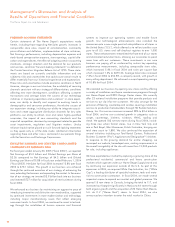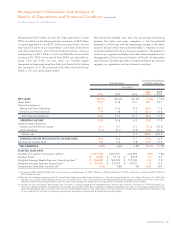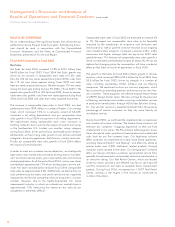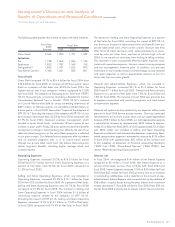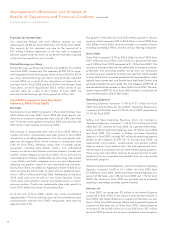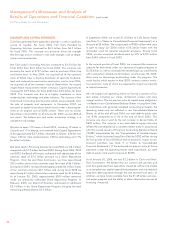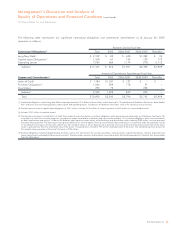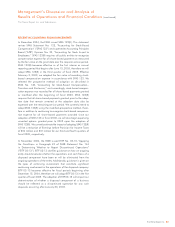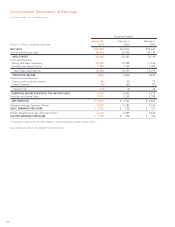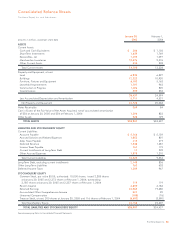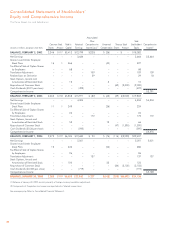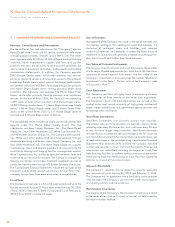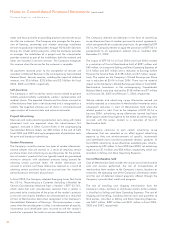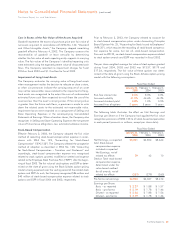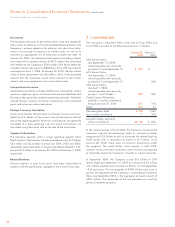Home Depot 2004 Annual Report Download - page 24
Download and view the complete annual report
Please find page 24 of the 2004 Home Depot annual report below. You can navigate through the pages in the report by either clicking on the pages listed below, or by using the keyword search tool below to find specific information within the annual report.
Management’s Discussion and Analysis of
Results of Operations and Financial Condition (continued)
The Home Depot, Inc. and Subsidiaries
22
QUANTITATIVE AND QUALITATIVE DISCLOSURES
ABOUT MARKET RISK
Our exposure to market risk results primarily from fluctuations in
interest rates. Although we have international operating entities,
our exposure to foreign currency rate fluctuations is not significant
to our financial condition and results of operations. Our primary
objective for entering into derivative instruments is to manage our
exposure to interest rates, as well as to maintain an appropriate
mix of fixed and variable rate debt.
As of January 30, 2005, we had $995 million of 33⁄4% Senior Notes,
net of a $5 million discount, and $500 million of 53⁄8% Senior
Notes outstanding. The market values of the publicly traded 33⁄4%
and 53⁄8% Senior Notes as of January 30, 2005, were approximately
$989 million and $515 million, respectively. We have several
outstanding interest rate swap agreements, with notional amounts
totaling $475 million, that swap fixed rate interest on our $500 million
53⁄8% Senior Notes for variable interest rates equal to LIBOR plus
30 to 245 basis points and expire on April 1, 2006. At January 30,
2005, the fair market value of these agreements was $6 million,
which is the estimated amount that we would have received to sell
similar interest rate agreements at current interest rates.
IMPACT OF INFLATION, DEFLATION AND
CHANGING PRICES
We have experienced inflation and deflation related to our
purchase of certain commodity products. During fiscal 2004, rising
lumber prices increased our comparable store sales by approxi-
mately 100 basis points. We do not believe that changing prices for
other commodities have had a material effect on our Net Sales or
results of operations. Although we cannot accurately determine the
precise overall effect of inflation and deflation on operations, we
do not believe inflation and deflation have had a material effect on
our results of operations.
CRITICAL ACCOUNTING POLICIES
Our significant accounting policies are disclosed in Note 1 of our
Consolidated Financial Statements. The following discussion
addresses our most critical accounting policies, which are those
that are both important to the portrayal of our financial condition
and results of operations and that require significant judgment or
use of complex estimates.
Revenue Recognition
We recognize revenue, net of estimated returns, at the time the
customer takes possession of the merchandise or receives services.
We estimate the liability for sales returns based on our historical
return levels. The methodology used is consistent with other retail-
ers. We believe that our estimate for sales returns is an accurate
reflection of future returns. We have never recorded a significant
adjustment to our estimated liability for sales returns. However, if
these estimates are significantly below the actual amounts, our
sales could be adversely impacted. When we receive payment from
customers before the customer has taken possession of the
merchandise or the service has been performed, the amount
received is recorded as Deferred Revenue in the accompanying
Consolidated Balance Sheets until the sale or service is complete.
Merchandise Inventories
Our Merchandise Inventories are stated at the lower of cost (first-
in, first-out) or market, with approximately 89% valued under the
retail inventory method and the remainder under the cost
method. Retailers like The Home Depot, with many different types
of merchandise at low unit cost and a large number of transac-
tions, frequently use the retail inventory method. Under the retail
inventory method, Merchandise Inventories are stated at cost, which
is determined by applying a cost-to-retail ratio to the ending retail
value of inventories. As our inventory retail value is adjusted regu-
larly to reflect market conditions, our inventory methodology
approximates the lower of cost or market. Accordingly, there were
no significant valuation reserves related to our Merchandise
Inventories as of January 30, 2005 and February 1, 2004.
Independent physical inventory counts are taken on a regular basis
in each store and distribution center to ensure that amounts
reflected in the accompanying Consolidated Financial Statements
for Merchandise Inventories are properly stated. During the period
between physical inventory counts, we accrue for estimated losses
related to shrink on a store-by-store basis. Shrink is the difference
between the recorded amount of inventory and the physical inven-
tory. Shrink (or in the case of excess inventory, “swell”) may occur
due to theft, loss, improper records for the receipt of inventory or
deterioration of goods, among other things. We estimate shrink as
a percent of Net Sales using the average shrink results from the
previous two physical inventories. The estimates are evaluated
quarterly and adjusted based on recent shrink results and current
trends in the business.
Self-Insurance
We are self-insured for certain losses related to general liability,
product liability, automobile, workers’ compensation and medical
claims. Our liability represents an estimate of the ultimate cost of
claims incurred as of the balance sheet date. The estimated liabil-
ity is not discounted and is established based upon analysis of
historical data and actuarial estimates, and is reviewed by
management and third-party actuaries on a quarterly basis to
ensure that the liability is appropriate. While we believe these esti-
mates are reasonable based on the information currently available,
if actual trends, including the severity or frequency of claims,
medical cost inflation, or fluctuations in premiums, differ from our
estimates, our results of operations could be impacted.




